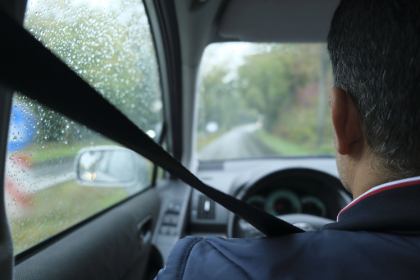INDEPENDENT DEALER
Mandan, ND | (701) 426-8970
OUR BLOG
Don't let spring showers dampen your drive. Learn essential tips for safe driving in the rain, and get your vehicle ready with OilWerx in Mandan, ND.

May showers bring more than flowers – they bring slick roads and reduced visibility. For many, driving in the rain can be a nerve-wracking experience. But with some preparation and mindful driving habits, you can confidently navigate wet roads. Let's dive into some essential tips to keep you safe when the skies open up.
Don't let rainy roads catch you off guard! Ensure your vehicle is prepped for wet weather with essential maintenance. OilWerx in Mandan, ND, can help you keep your car running smoothly and safely. Call us at (701) 426-8970 for expert advice, or explore AMSOIL's online store to find the right solutions for your vehicle.
Preparing Your Vehicle for Wet Weather
Before you turn the key, ensure your vehicle is ready for the rain. Start with your tires. Proper tire pressure and tread depth are crucial for maintaining traction on wet surfaces. Inspect your tires regularly for wear and tear and replace them when necessary. Remember, worn tires are more prone to hydroplaning, a dangerous situation in which your tires lose contact with the road surface.
Next, check your windshield wipers. Make sure they are in good condition and clear the windshield effectively. Streaking or skipping wipers can severely impair your visibility. Replace worn wiper blades promptly. Don’t forget to check your windshield washer fluid level and ensure it’s filled with a solution that can cut through grime and rain.
Your vehicle's lights are also vital for visibility in rainy conditions. Check that your headlights, taillights, and brake lights work correctly. Use your headlights even during daylight hours in heavy rain to increase your visibility to other drivers.
Safe Driving Techniques for Rainy Conditions
Once you're on the road, adjust your driving habits to suit the wet conditions. Reduce your speed and increase your following distance. Remember that it takes longer to stop on wet roads, so give yourself plenty of space between your vehicle and the car in front of you.
Avoid sudden braking or steering maneuvers. Smooth, gradual movements are key to maintaining control in the rain. If you start to hydroplane, don't panic. Gently ease off the accelerator and steer in the direction you want to go. Avoid sudden braking or sharp turns.
Be extra cautious when driving through puddles. You never know how deep they are or what hazards lurking beneath them. If possible, avoid driving through large puddles altogether. If you must drive through one, do so slowly and steadily. After driving through a puddle, gently tap your brakes to dry them.
Rainy season is here! Protect your vehicle from the elements with a thorough maintenance check. OilWerx in Mandan, ND, is your local source for quality vehicle care. Discover how we can help you stay safe on slick roads. Call (701) 426-8970 for more information, or visit AMSOIL’s online store today.
Visibility and Awareness
Reduced visibility is one of the biggest challenges when driving in the rain. Use your headlights and windshield wipers to maximize your visibility. If the rain is particularly heavy, consider pulling over to a safe location until the storm passes.
Be aware of your surroundings and anticipate the actions of other drivers. Rainy conditions can make it difficult for drivers to see and react, so stay alert and be prepared for unexpected situations.
Understanding the Dangers
Driving in the rain presents unique challenges. One of the most significant dangers is reduced traction. Wet roads can be incredibly slippery, especially in the first few minutes of rain when oil and debris rise to the surface. This can lead to skidding, hydroplaning, and loss of control.
Another danger is reduced visibility. Heavy rain can make it difficult to see other vehicles, pedestrians, and road hazards, increasing the risk of accidents, especially at intersections and in areas with poor lighting.
Finally, flooding is a serious concern during heavy rain. Never attempt to drive through flooded roads. The water may be deeper than it appears, and you could become stranded or swept away.
Staying Informed and Prepared
Before heading out in rainy weather, check the weather forecast and traffic conditions. If possible, avoid driving during heavy rain or thunderstorms. If you must drive, allow extra time for your journey and be prepared for delays.
By following these tips, you can navigate rainy conditions safely and confidently. Remember, the key is to be prepared, drive cautiously, and stay aware of your surroundings. Stay safe and dry this May!